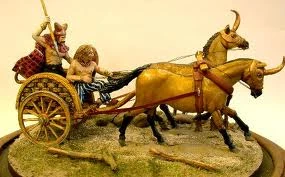
Celtic War Chariot
The chariot is the earliest and simplest type of horse carriage used in both peace and war as the chief vehicle of many ancient peoples. They were use by many cultures including but not limited to the Celts, Persians, Carthaginians, Greeks, Romans and Egyptians.
History
Chariots are generally believed to have been developed in Mesopotamia around 3000 BC. The earliest chariots, pulled by oxen or donkeys before the introduction of horses in 2000 BC, had solid wooden wheels and were constructed from animal hides. These heavy proto-chariots may have been used for transportation of supplies and high-ranking soldiers rather than for battle.
The first known use of war chariots comes from the 17th Century BC, in the Hittite Empire (in modern day Syria and Lebanon). The Hittites were renowned charioteers, developing a new chariot design with lighter wheels and carrying three warriors rather than two, as most chariots are designed. Chariots later spread to Egypt, where the design was further improved. The Battle of Kadesh in 1274 BC, fought between the Egyptian Empire under Rameses II and Hittite Empire led by Muwatalli II, is generally regarded as the largest chariot battle of all time, with between 5,000 and 6,000 chariots between the two armies.
Ancient Carthage also used war chariots up until the 3rd century BC. These were constructed from wooden frames covered with panels of woven willow branches. They were single-axle chariots and could carry two men (a driver and an archer). Sometimes a third man, a hoplite, would join them. The chariot was pulled by two or four horses while the animals were protected with metal breastplates and ox-hide side covers. Like cavalry, they were used to break up the enemy infantry lines. Needing flat terrain to operate effectively they were largely restricted to use in North Africa and southern Spain
Design
Chariots used for war were generally two wheeled and designed to carry two people, the driver and warrior. All chariots used for war are relatively the same. Most differences are minor and mostly aesthetic. One unique chariot was the Celtic chariot, with its free-hanging axle, suspended from the platform with rope. This allowed for a much more comfortable ride on bumpy terrain. War chariots of some cultures (most notably the Persian war chariots) had chariot scythe attached to the axles of the chariot.
Advantages
The chariot gave whatever warrior using them the great advantage on the battlefield. The speed allowed the warriors on them to quickly travel around the battlefield to where they were needed. Also any warrior striking from the chariot could hit with greater force due to the speed of the chariot. The fact that a chariot is a mobile platform, archers could ride around the enemy firing into enemy units with out fear of having to face heavily armed units. Additionally, the chariot if properly made could drive right over light infantry.
Disadvantage
A chariot has to have a driver in order to work, and if the driver is injured or killed the warrior had to abandon the chariot or drive it away himself, losing his ability to attack. Early chariots were relativly light and weak and could break relatively easily. If a single horse is killed in the team, the chariot can't be used until it is cut free and/or replaced. Compared to a single horse, the chariot is slower and less maneuverable.
In Show
In the show only the Celt and Immortal have used chariots so far. With the exception of the chariot scythe all other weapons for both warriors were capable of being used without a chariot.
Trivia
- One primary reason why Chariots existed before horseback riding is because in the Bronze Age: most domesticated horses were too small and thus too weak to support a rider. Eventually selective-breeding strengthened the horses armies had and eventually led to horseback riding replacing the chariot.